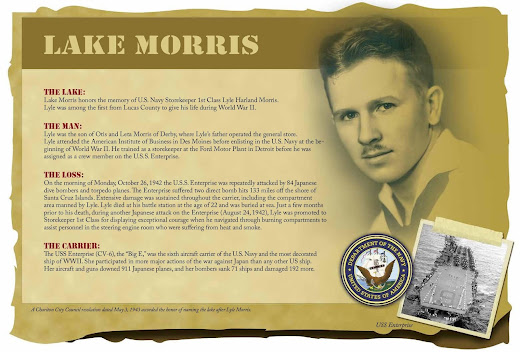I'm happy to report that U.S. Army Air Corps Staff Sgt. Roy Ellis, after whom Chariton's Lake Ellis is named, will be honored this summer by installation of this interpretive sign on the north shore of his lake.
Eighty-one years have passed since the young man from Williamson gave up his life while in service to his country during World War II; eighty years have passed since the lake and its companion, Lake Morris, were named to honor Lucas County's first confirmed fatalaties of World War II.
City Manager Laura Liegois signed off on the design last week, authorizing its designer Patrick Ranfranz, to place the order. It will be shipped to Chariton upon completion.
+++
The Lake Ellis part of the project needed separate funding in order to be realized, funding that was not available until this year.
+++
Here's how the text on the new Lake Ellis sign will read:
The Man: The name "Lake Ellis" honors the memory of U.S. Army Air Corps Staff Sgt. Roy Ellis, son of Frank and Mary Ellis of Williamson, who was the first confirmed Lucas County fatality of World War II. Roy's parents were both immigrants from Italy who married at Attica in Marion County in 1916. The family name was Lesali, but "Ellis" was chosen because they both passed through Ellis Island on their way to new lives in the United States. Roy Graduated from Williamson High School in 1937. After graduation, he joined his father working in the nearby coal mines. Roy enlisted in the U.S. Army Air Corps on Oct. 8, 1940, at age 20, in Ottumwa. After initial training, he was assigned to the 38th Bombardment Squadron, 30th Bombardment Group, stationed in New Orleans. By June of 1942, Roy had been assigned as a radioman to the 11th Air Force, 28th Bombardment Group, 21st Bombardment Squadron, headquartered at Elmendorf Airfield at Anchorage.
The Plane: The B-24 Liberator was a four-engine American heavy bomber. It was produced in greater numbers than any other American combat aircraft of World War II and still holds the record as the most produced U.S. military aircraft. Often compared to the better-known B-17 Flying Fortress, the B-24 was a more modern design with a higher top speed, greater range and higher bomb load. The B-24 provided excellent service in a variety of roles thanks to its large payload and long range. 18,482 B-24s were built by September 1945.
The Mission: On June 11, 1942, Roy's B-24 bomber was shot down by anti-aircraft fire attacking the Japanese-held Aleutian Islands. Roy was killed in action on his first mission. The Japanese landing and occupation of Kiska and Attu, Alaska, in June 1942, were the only two invasions of the United States during the war. The mission was the first by the 11th Air Force against Kiska, Alaska, and consisted of six Liberators with Roy's plane, piloted by Jack Todd, in the lead. The planes took off from Cold Bay Airfield, landed at Umnak Airfield to load bombs and then headed to Kiska. Over Kiska, Japanese anti-aircraft fire hit the lead plane with Roy and nine others aboard. The plane exploded in midair with so much force that it jammed the bomb-bay doors on the two flanking B-24s, then crashed in pieces onto the tundra on a hillside overlooking Trout Lagoo, killing all 10 aboard. Three of the planes were able to drop their bombs, and five of six returned safely to home base. In 1949, the remains of the Todd crew were recovered on Kiska. The remains were buried together in 1949 in one grave at Fort Leavenworth National Cemetery in Kansas.
+++
And here's the sign honoring Lyle Morris, installed during 2015 (the original sign also will be replaced with a duplicate this summer because of damage inflicted by vandalism).
Lake Ellis was built during 1915-1916 as the source of Chariton's water supply and Lake Morris was added during 1941-1942 to supplement it.
The lakes had no formal names until 1943, when a naming contest was held. It was Mrs. Clara Rutherford who suggested that they be named to honor the two young men who were Lucas County's first confirmed deaths during World War II --- Roy on June 11, 1942, and Lyle on Oct. 26, 1942. That was made official by a City Council resolution dated May 3, 1943.
After World War II ended, it was discovered that U.S. Army Air Corps Sgt. Andy Knapp actually had been the first Lucas Countyan to give up his life --- on or about June 2, 1942, in a Japanese prisoner of war camp, Bataan, the Philippines.
Lakes Ellis and Morris provided Chariton's water supply until quite recently, when the city joined the Rathbun Rural Water Association. The new signage is part of an ongoing project to form an action plan for the lakes' future as recreational assets for the city.




No comments:
Post a Comment